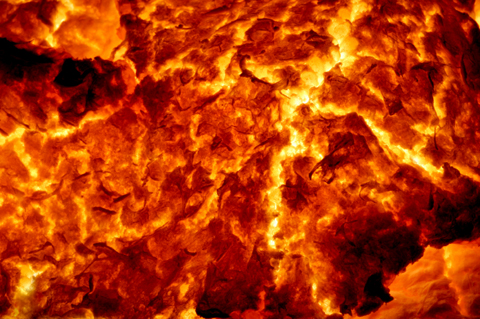 The Earth’s climate has gone from Greenhouse to Hothouse more than dozen times this eon. Each time, researchers say, magma brought the heat.
The Earth’s climate has gone from Greenhouse to Hothouse more than dozen times this eon. Each time, researchers say, magma brought the heat.
Dr. David L. Kidder is helping to characterize the Hothouse planetary state by studying times when the Earth’s deep-level plumbing system sent large volumes of magma to the surface. Researchers call these short duration events “Large Igneous Provinces.” Igneous is Latin for “fire,” and igneous rock is cooled magma or lava.
Kidder is studying the current geologic eon—the Phanerozoic, the last 540 million or so years.
But the study of paleoclimate is a recent event.
“When Alfred Fischer proposed that Earth alternated between icehouse and greenhouse states through Phanerozoic history (in 1981), he suggested that changes between these states were strongly influenced by volcanic release of carbon dioxide to cause climate warming, and that cooling could be driven by withdrawal of this atmospheric greenhouse gas as rocks weathered and carbon was buried during sedimentation,” write Kidder and Worsley in “Large Igneous Provinces Trigger Hothouse Climate,” published August 2013 by the Large Igneous Provinces Commission.
“With the increase in global paleoclimate studies in recent decades, terms like supergreenhouse, hothouse, and hyperthermal event arose in the literature, implying that there are intervals in Phanerozoic history that are warmer than a typical greenhouse climate. Our synthetic analysis of a particularly warm interval associated with the end-Permian extinction led us to introduce descriptive and functional criteria that help distinguish icehouse, greenhouse, and hothouse climates,” they say.
“In our recent model, we suggested that geologically short hothouse excursions that typically last less than 1 million years be named HEATT episodes, where HEATT stands for Haline Euxinic Acidic Thermal Transgression. We hypothesized that changes in the Earth system should be governed by principles of global heat transport as they relate to planetary windbelts and ocean circulation. We then synthesized geologic, paleontologic, paleoceanographic, and paleoclimatic data, and integrated those results so as to test theoretical predictions,” says Kidder, Associate Professor of Geological Sciences at Ohio University.
“Our hothouse model explains the systemic interplay among factors including warmth, rapid sea-level rise, widespread ocean anoxia, ocean euxinia that reaches the photic zone, ocean acidification, nutrient crises, latitudinal expansion of desert belts, intensification and latitudinal expansion of cyclonic storms, and more,” they wrote in a 2012 GSA Today article.
Earth Has Been an Icehouse for Past 35 Million Years
In 2012, Kidder and Worsley asked the question, “Can rapid human climate-warming activities force the current icehouse climate into a hothouse climate?”
Most of the current eon has been a Greenhouse climate they suggest. And the dozen or so large magma events took the planet to Hothouse. The Earth is currently in an Icehouse phase.
“In our model, we assume that a weak thermal mode, defined by sinking of cool, but not frigid polar sinking waters that very sluggishly fill the deep ocean characterizes greenhouse climate. We suggested that greenhouse conditions characterized about 70 percent of the Phanerozoic. We proposed the greenhouse as a default state from which icehouse and hothouse climates can be forced,” they write in the Large Igneous Provinces Commission article.
“Cooling to an icehouse (e.g. via orogenically intensified silicate weathering and related carbon burial) leads to glaciation and polar sinking of thermal-mode cold brines. Warming from greenhouse to hothouse is driven by large igneous provinces emissions of greenhouse gases. Under favorable preconditions (i.e. in the absence of significant competing cooling forcing mechanisms), a warm greenhouse climate can be forced to a hothouse state via a LIP trigger. ”
A Human-Induced Hothouse Climate?
“Humans can raise global atmospheric CO2 to levels known from much warmer ancient climates,” they conclude in the GSA article. “Conditions in some of those warm climates will probably be achieved if current levels of carbon emissions continue, although precise prediction of the degree and rate of warming is difficult. A cool greenhouse … in which the tropics and deep sea warm, most northern ice melts appears within reach if human greenhouse gas emissions continue at their present rate.”
“We suspect it will be difficult for humans to force Earth from the current icehouse to a hothouse. The likely cool greenhouse in which about half of Antarctica is still ice-covered means devastation from the tens of meters sea level is likely to rise, and poleward shifting of warm climate belts. Although a hothouse may not occur because economic crises or intentional climate-mitigating efforts by humans or fossil-fuel exhaustion limit greenhouse gas emissions, even a cool greenhouse climate will severely disrupt many societies and economies.”
“Feedbacks and still-unknown amplifiers will ultimately control just how far humans can force climate toward a hothouse. Uncertainties over these feedbacks should not distract us from the likelihood that a cool greenhouse seems imminent within perhaps a century or two. Long atmospheric CO2 residence times will probably keep Earth from returning to an icehouse for centuries to millennia unless active removal of CO2 from the atmosphere is undertaken.”
Read more about how “Large Igneous Provinces Trigger Hothouse Climate.”


















Comments